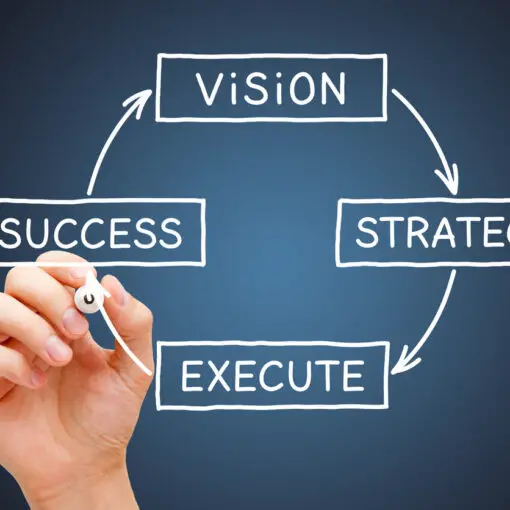Strategic thinking is a critical skill that permeates every level of an organization, driving decision-making and long-term success. It involves the analysis of key drivers behind a business, understanding the needs and predict future trends to stay ahead. Leaders with strong strategic thinking skills not only shape their own career paths but also contribute immensely to the advancement of their organizations. They harness a blend of innovation, analytical prowess, and foresight to navigate the complex business landscape.

In the quest for excellence and effective leadership, it is crucial for individuals to foster a strategic mindset. This includes being able to plan meticulously while staying flexible enough to adapt to changing environments. Strategic thinking equips leaders with the tools required for successful strategic planning and execution, ensuring that they can lead with conviction through strategic initiatives. A focus on innovation and an acute understanding of disruption can position a leader not just to react to changes but to actively drive them. Furthermore, measuring effectiveness and strategic impact is an integral part of determining the success of an individual’s strategic approach within an organization.
Key Takeaways
- Strategic thinking is essential for career progression and organizational success.
- Strategic planning and adaptability are key components of effective leadership.
- Measuring strategic outcomes is crucial for sustaining competitive advantage.
Fundamentals of Strategic Thinking

Strategic thinking is an essential competency that combines various skills to analyze the current state, envision a desired future, and bridge the gap effectively. It often involves recognizing patterns, exploring complex scenarios, and being adaptable to change.
Embracing Complexity and Change
An essential element in the fundamentals of strategic thinking is the ability to embrace complexity and change. Organizational environments are dynamic, and those adept at strategic thinking acknowledge that change is constant. They use complex data and varying perspectives to inform decision-making, and maintain agility in their strategies, aware that today’s solutions may not solve tomorrow’s problems.
Assumption-Based Planning
Assumption-based planning is another pivotal aspect that underpins strategic thinking. Here, one identifies assumptions that form the basis of strategic plans and continually assesses their validity. Challenging these assumptions is key; if they prove obsolete, one must adapt the strategy to stay aligned with long-term objectives and promote organizational learning.
Developing a Strategic Mindset
To foster strategic thinking skills crucial for long-term success, developing a strategic mindset is imperative. Individuals cultivate this by questioning the status quo, exploring new opportunities, and learning both from success and failure. They not only navigate today’s complexity but do so with an eye on the future, ensuring that strategies are sustainable and forward-thinking.
Strategic Planning and Execution

In the landscape of business strategy, the seamless integration of strategic planning and execution is critical to organizational success. They work together to provide direction and a compass for measuring progress toward goals.
Aligning Strategic Planning with Action
Strategic planning must translate into tactical actions for any plan to succeed. This critical alignment involves the translation of high-level strategic objectives into executable activities and projects. A study on the effectiveness of strategic planning points out that a formal process that includes analyzing internal and external factors is integral to enhancing organizational performance. Successful organizations ensure that each strategic goal has corresponding actions, timelines, and responsible parties defined.
Resource Allocation and Priorities
Allocating resources efficiently underpins successful strategic execution. Organizations must prioritize their objectives, dedicating resources—capital, personnel, and time—to areas that buttress their strategy. This requires a process of continuous review to shift resources to high-priority initiatives and away from areas of lower strategic alignment. Decisions about resource allocation reflect an organization’s commitment to its strategic plan and its adaptability to changing circumstances.
Monitoring and Testing Strategies
Once action plans are underway, monitoring and assessing the effectiveness of strategies become vital. This involves establishing key performance indicators (KPIs) and regular reporting mechanisms to gauge progress. Continuous testing of strategies ensures that assumptions made during the planning phase are validated against real-world results. Organizations may need to iterate and adjust their strategies in response to new data or changing market conditions to achieve their desired outcomes.
Leading Through Strategic Initiatives
In the realm of business leadership, the enactment of strategic initiatives is pivotal. Successful execution hinges on the ability to cultivate leadership qualities across all organizational tiers, actively promote these initiatives for maximum engagement, and make decisions that align with the overarching strategic vision.
Cultivating Leadership at Every Level
Organizations thrive when they foster leadership skills not only among executives but at every level. According to insights from the Harvard Business Review, it is insufficient for professionals to simply develop strategic thinking skills; they must also be capable of demonstrating them. By encouraging team members to take ownership of their roles within strategic initiatives, companies can create a powerful, organization-wide impetus for change and innovation.
Promotion of Strategic Initiatives
The promotion of strategic initiatives is essential for garnering support and achieving the intended impact. For instance, the Harvard Business Publishing elaborates on the concept that good ideas can stem from any level within the organization. Clear communication of the initiatives’ objectives and benefits plays a crucial role in securing commitment from all stakeholders, boosting the chances of successful implementation.
Effective Decision-Making
Effective decision-making serves as the backbone of executing strategic initiatives. Leaders must be adept at analyzing complex situations, considering various perspectives, and making choices that propel the organization towards its strategic goals. An article on cultivating strategic thinking emphasizes that leaders equipped with broad knowledge and extensive experience are best positioned to develop the strategic thinking necessary for high-level decision-making. These decisions, when well-informed and strategically aligned, advance the organization’s strategic agenda and drive meaningful progress.
Innovation and Disruption
In the evolving landscape of business, innovation and disruption form the cornerstone of staying relevant. They delve into the transformative strategies enterprises employ to lead and redefine markets.
Adapting to Market Changes
Adapting to market changes is imperative for businesses aiming to stay competitive. An article from the Harvard Business Review outlines a new approach that aids leaders in aligning their innovation strategies with market dynamics. This continual alignment is not just about adopting new technologies but also about understanding and anticipating market shifts to maintain a strategic edge.
Creating Disruptive Business Models
The creation of disruptive business models involves overturning conventional industry methods and establishing new market footholds. Renowned for insight into this phenomenon, an essential read includes The Essential Clayton Christensen Articles, which revisit the nuances of disruptive innovation and its impact on business growth and sustainability. These models rely on identifying unmet needs and deploying innovative solutions that resonate with those needs, potentially capturing a new customer base.
Fostering Innovation Within the Organization
Organizations must foster an environment where innovation can thrive internally. It involves encouraging a culture of creativity and continuous improvement, where employees are empowered to experiment and contribute ideas. A case study, detailed in a scholarly publication, highlights how design thinking can respond to disruptive innovation, suggesting that this methodology can effectively incubate and implement ideas that lead to significant organizational advancements.
Measuring Effectiveness and Strategic Impact
Effective measurement is crucial for determining the impact of strategic initiatives and informing future decisions. This segment highlights mechanisms for setting benchmarks, tracking progress, and objectively analyzing strategic outcomes.
Setting and Tracking Strategic Goals
Organizations need to define clear, measurable goals that align with their overarching priorities. It begins with identifying what success looks like and then breaking it down into quantifiable targets. Strategic goals should include key performance indicators (KPIs) that are tailored to stakeholders’ expectations and market demands. For instance, to enhance customer satisfaction, they might track metrics related to client feedback or net promoter scores.
Evaluating Outcomes and Learning
Once goals are set and data are collected, organizations must critically evaluate their results against the set benchmarks. This involves not only measuring the outcomes but also understanding the underlying factors that contributed to those results. Learning from both successes and shortcomings is instrumental for refining strategic decisions and future planning. They should analyze if the actions taken have truly addressed the stakeholders’ interests and led to effective customer engagement.





